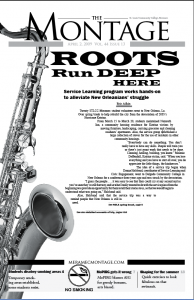Service Learning program works hands-on to alleviate New Orleanians’ struggle
Twenty STLCC-Meramec student volunteers went to New Orleans, La. Over spring break to help rebuild the city from the devastation of 2005’s Hurricane Katrina.
From March 15 to March 20, students maintained Nazareth Inn, a community housing residence for Katrina victims by moving furniture, landscaping, carrying groceries and cleaning residents’ apartments. Also, the service group refurbished a large collection of stoves for the use of residents in other community housings.
“Everybody can do something. You don’t really have to have any skills. People will train you or there’s just grunt work that needs to be done. Cleaning, hauling, building, you know.” Melanie Deffendall, Katrina victim, said. “When you lose everything and you have to start all over, you do appreciate the little things, the kindnesses.”
The idea of a service trip began when Donna Halsband, coordinator of Service Learning and Civic Engagement, went to Delgado Community College in New Orleans for a conference three years ago and was struck by the devastation.
“I guess the people . . . it was easy to see that they could cry at any second and as you’ve seen they’re still that way, and so what I really wanted to do with the service piece from the beginning was provide an opportunity for them to tell their stories to us, so that we would begin to
understand what was going on,” Halsband said.
Also, Halsband said that the service trip was a way to remind people that New Orleans is still in need.
of aid.
“I wanted students to really see what was going on down here because it was starting to become a non-issue for people all over the country,” Halsband said. “They figured things were solved down here, that things were okay. And of course, as we know from being here they aren’t okay and it’s going to be years before they are okay.”
Michael Foster, service trip advisor, agreed that a lack of awareness of the state of New Orleans is a problem.
Foster said, “I talked to a lot of classes about coming on this trip and one of the most common reactions was, ‘It’s still that bad down there?’.”
After working for most of each day, the student volunteers spent the rest of their time in New Orleans exploring different parts of the city, including the French Quarter and Delgado Community College.
The group also toured a neighborhood called the Lower Ninth Ward, many houses in which were not only flooded by Hurricane Katrina, but smashed or knocked off their foundations completely by flood waters.
“It’s not just like your house burned down. It’s like everybody on your block is gone and they’re not coming back,” said Joseph Fortenberry, long-term volunteer for Catholic Charities. “I don’t know what you can learn from that. You can learn a lot from that. Learn to have hope, I guess, if you’re coming back.”
According to Kevin Fitzpatrick, Volunteer Housing Coordinator for Catholic Charities, not only is there hope in New Orleans, but the city has also become more closely knit together since Katrina, despite the devastation.
“[We’ve learned] the importance of being helpful, checking with one another to make sure that we have an evacuation plan. When we had [Hurricane] Gustav come through, there was a lot more awareness of making sure everybody had a way out,” Fitzpatrick said.
“The other thing, we’ve learned to appreciate what we have here as far as our food and our culture. We always had that, we knew it, but we appreciate it in a whole new way.”
However, Fitzpatrick said that despite the renewed closeness of the city, a steady stream of volunteer help is necessary for New Orleans to return to normal.
“The horror is always going to be with us. So whether it’s restoration or housing, we feel like that need is always going to be with us,” Fitzpatrick said.
The need for volunteers in New Orleans may be continued to be filled by Meramec, as discussions about a similar service trip next year have already been started by Halsband.











